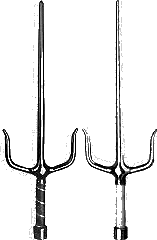
Sai (sigh)
The three pronged, metal truncheon is a unique weapon believed to have been introduced to Okinawa by the Chinese in and around the late 1400's. The sai was employed by the local law enforcement the same way the modern day police use their night stick. There has been some controversy and even some speculation as to the origin of the sai. Some believe it to be a weapon that was created as opposed to a farming or fishing tool, similar to a tool used in China to create holes in the ground for seeds. Some even believe that the sai were at one time a bladed weapon.
By gripping them with either the honte mochi and gyaku mochi, the practitioner can manipulate the sai with deadly speed and accuracy. With the sai, the shaft is referred to as the monouchi (moh-noh-oo-chee), the tip is the saki (sah-kee), and the bottom rounded part of the handle is the tsukagushira (tsue-kah-ghoo-she-rah). A quarter way up the shaft are two curved prongs called the yoku (yoh-kuh) and the tip of the prongs are called tsume (tsue-meh). The size of the sai depend on the individual using them. The monouchi should cover the forearm with the saki extending at least one inch past the elbow. The size of the yoku are important also; because of the grappling and catching abilities of the sai the distances between the monouchi and the yoku should be narrow. The sai employs striking, blocking, punching, cutting, and stabbing capabilities.
